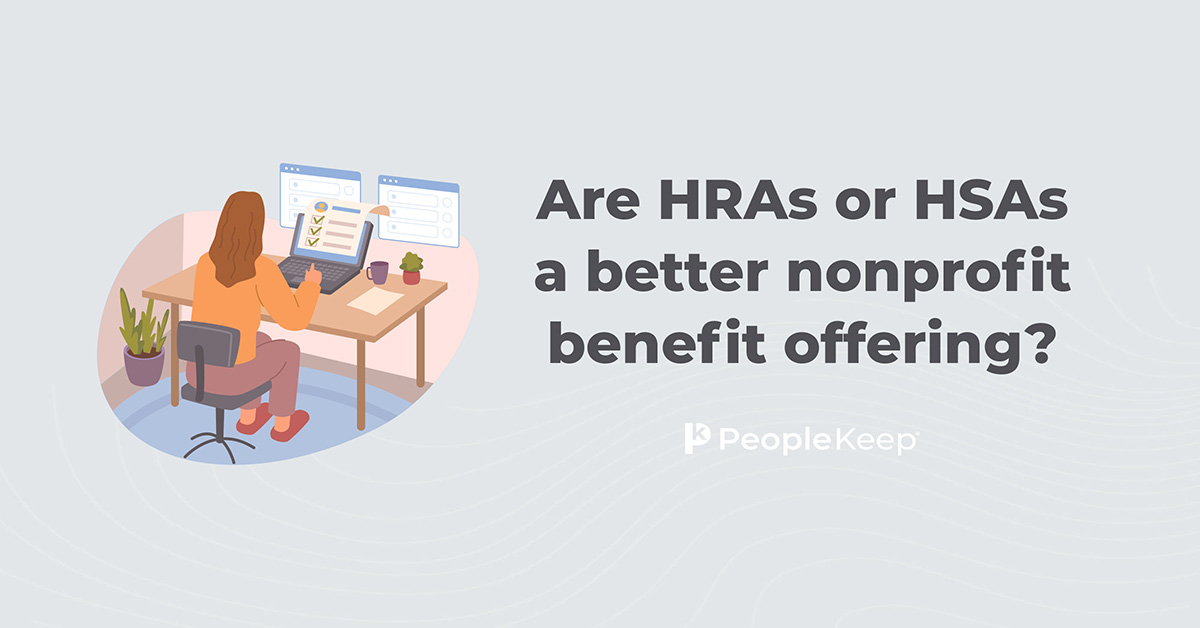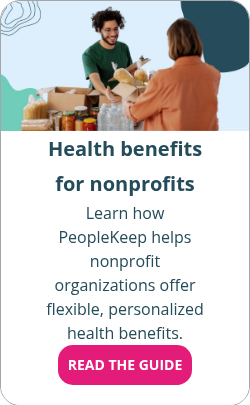The nonprofit’s checklist for choosing health insurance
By Elizabeth Walker on March 18, 2024 at 9:00 AM
Small nonprofit organizations face unique challenges in hiring and retaining talented employees. In many cases, nonprofits have limited resources compared to for-profit businesses, so leadership teams may have to make more strategic decisions when allocating budget toward compensation and employee benefits.
The cost of offering health insurance is steadily rising each year. According to Mercer, American employers expect the total health benefit cost per employee to rise 5.4% on average in 2024 due to inflation and labor shortages in previous years1.
Given these pressures, what steps must a nonprofit employer take to choose an affordable and comprehensive health insurance option for their business? In this article, we’ll guide you through the top four questions every nonprofit employer should ask when making healthcare decisions for their organization.
Takeaways from this blog post:
- Regardless of whether the Affordable Care Act (ACA) requires a nonprofit to offer health insurance, choosing to do so can have a positive impact on employee satisfaction, morale, hiring, and retention.
- Due to their participation requirements and high premium rates, group health plans may be out of reach for many nonprofit employers. Some more accessible health benefit options include health reimbursement arrangements (HRAs) and health and wellness stipends.
- Nonprofits must carefully consider how much they can spend on health benefits to get the most bang for their buck. However, understanding your employees' healthcare plan needs is just as crucial as securing budget-friendly and comprehensive coverage.
1. Do nonprofits have to offer health insurance?
The federal government doesn’t require all businesses to offer their employees a healthcare benefit. Therefore, your first step is determining your legal requirements regarding health insurance. Whether or not you need to provide employee medical coverage depends on your organization’s size.
Due to the Affordable Care Act (ACA) and the employer mandate, organizations with 50 or more full-time equivalent employees (FTEs) must offer affordable health coverage that meets minimum essential coverage (MEC) to at least 95% of their full-time employees and their dependents. If they fail to do so, they must pay a penalty.
Companies of this size are called applicable large employers (ALEs), and they can be any kind of employer, including nonprofit organizations, as long as they have at least 50 FTEs.
However, smaller organizations are different. Businesses with fewer than 50 FTEs don’t have to offer health insurance benefits to their employees, nor are they subject to the penalty if they don’t provide them.
So, if your nonprofit has fewer than 50 FTEs, you don’t have to offer health insurance. However, that doesn't mean you shouldn’t provide health benefits to employees, as it promotes greater employee retention, tax advantages, improved company morale, and an overall healthier organization.
2. Is offering health benefits worth the investment?
Given the rising costs of group health insurance, you may need to ask yourself if offering health benefits through a traditional group plan is worth your investment. After all, KFF reports that the average premium for self-only coverage in 2023 was $8,435 per year and $23,968 per year for family coverage2.
However, just because you can’t afford to invest in a group health insurance plan doesn’t mean you have to give up on offering comprehensive coverage. Several other excellent options, like health reimbursement arrangements (HRAs), allow nonprofits on a tight budget to provide a formal health benefit to help their employees cover their medical costs.
While offering healthcare coverage is an investment, it’s one that’s proven to be well worth it. According to a PeopleKeep survey, health insurance coverage is the most requested employee benefit, with 87% of employees valuing it and 92% of employers offering it.
What’s more, 96% of U.S. workers believe it’s crucial for employers to offer health insurance3. So, if you’re considering not offering a health benefit to save money, you may miss out on top-notch job seekers.
3. Which health benefit should I choose?
Once you’ve decided to invest in a health benefit, you’re ready to determine which plan option is best for your organization.
As previously mentioned, offering a traditional health insurance plan isn’t the only route nonprofit employers can take. There are also more flexible alternatives that may be more affordable and work better for your nonprofit organizations. We’ll cover a few options you can offer with PeopleKeep.
Qualified small employer HRA (QSEHRA)
The QSEHRA is an IRS-approved, employer-funded health benefit for organizations with fewer than 50 FTEs. Through a QSEHRA, nonprofit employers can reimburse their employees tax-free for qualifying medical expenses, including health insurance premiums up to an employer-defined monthly allowance amount.
QSEHRAs have maximum contribution limits set by the IRS each year. So when you’re designing your benefit, you can offer as much allowance as you want for single employees and those with a family, as long as it doesn’t exceed the maximum annual limit.
The flexibility and budget-friendly aspects of QSEHRAs make them very desirable to nonprofits. A recent PeopleKeep report found that 56% of nonprofits decided to offer a QSEHRA because they couldn't afford traditional group health insurance, and 25% chose a QSEHRA because they needed a more flexible benefit.
Whether your employees choose to purchase a plan on the federal Health Insurance Marketplace or from an insurance company directly, participate in their spouse’s or parent’s group plan, or enroll in Medicare, they can all benefit from a QSEHRA. Employee reimbursement amounts are income tax-free as long as their health insurance policy meets MEC.
Individual coverage HRA (ICHRA)
The ICHRA is another HRA that allows nonprofit employers to offer tax-free reimbursements on insurance premiums and other qualifying healthcare expenses. However, unlike a QSEHRA, an ICHRA is for organizations of all sizes.
The ICHRA is only available to employees with an individual health insurance plan. This means that employees covered by a spouse’s or family member's group health plan or an alternative policy, like a healthcare sharing ministry, can't participate in the benefit.
Additionally, nonprofit employers can offer different allowance amounts to employees based on 11 different employee classes, such as seasonal or salaried employees or employees living in other states, allowing you to customize your benefit even further.
One of the most significant advantages of an ICHRA is it can help large organizations satisfy the ACA employer mandate. However, you need to ensure your employees’ ICHRA allowances are affordable.
Integrated HRA
Suppose you decide that traditional group health insurance works well for your organization, but you want to offer a lower-cost plan to save money, such as a high deductible health plan. In that case, you can supplement your employees’ group coverage with an integrated HRA, otherwise known as a group coverage HRA (GCHRA).
Integrated HRAs are available to businesses of all sizes that offer a group health insurance policy. Only employees who opt into your company’s group plan can participate in this HRA.
With a GCHRA, your employees can get tax-free reimbursements on qualifying out-of-pocket healthcare costs not fully paid for by the group plan. There are no allowance limits, and, similar to the ICHRA, you can offer different allowance amounts based on seven employee classes.
Because of this flexibility, offering a GCHRA alongside your group health plan makes for an even more attractive health benefit for your employees.
Employee stipends
Another way you can reimburse your nonprofit employees for their medical expenses is with a health stipend. A health stipend is simply extra money you offer your employees in addition to their regular wages to pay for medical insurance and other out-of-pocket healthcare costs. Because the IRS considers stipends additional income, they are subject to income taxes.
You can offer a stipend as a one-time lump sum or on a regular basis, such as monthly, quarterly, or annually. If you want to use a reimbursement method, employees submit a request for their medical expenses and typically receive their reimbursement on their next paycheck.
But, since they are less formal and have fewer regulations than other health benefits, you can’t ask your employees for proof of a medical plan or receipts that they received medical care. Also, stipends don’t satisfy the employer mandate if your organization is an ALE.
If you have a big benefits budget, you can offer a wellness stipend alongside a health stipend. While health stipends cover insurance premiums and other eligible expenses, employers primarily use wellness stipends to reimburse physical and mental wellness costs, like fitness trackers, gym memberships, exercise equipment, and other healthy lifestyle items.
Health and wellness stipends can work alongside other health benefits, like traditional employer-sponsored health plans or HRAs, making them a flexible and complementary additional benefit to your compensation package.
Better yet, there are no eligibility requirements or contribution limits, so they’re a great option for nonprofits of any size to design their stipend to meet their needs and budget.
4. How much can I afford to spend on health benefits?
Finally, the last decision you must make is choosing how much money to invest in your employees’ health benefits. With an HRA or stipend, you can select your monthly allowance amount, making it completely customizable and financially low-risk.
According to PeopleKeep customer data, employees primarily use their HRA to pay for their individual health insurance premiums. Because of this, it makes sense to set your HRA allowance amount to be at or above the average monthly individual premium cost in your area.
Our 2023 nonprofit report shows that nonprofit organizations' average monthly QSEHRA allowance in 2022 was $466. Depending on your organization’s budget, you can aim to cover a percentage of your employees’ premiums or the entire cost.
While the Internal Revenue Code (IRC) allows organizations to use their HRA to reimburse their employees for more than 200 out-of-pocket medical expenses listed in IRS Publication 502, one way to ensure budget control is to reduce this list.
Your organization may exclude prescription drugs from reimbursement or make only premiums eligible through your HRA. This would limit your expense liability and save you money.
However, it’s important to remember that employees often get the greatest value from their HRA and stipend when they cover a wide range of potential healthcare needs. You should evaluate your organization’s budget and your staff’s needs before cutting options out of the benefit. Reducing your allowance is likely the better option.
Conclusion
Ultimately, the best approach in health benefit plan design is creating one that achieves your recruiting and retaining goals, meets the benefits expectations of your employees, and stays within your budget. By answering the four questions we’ve listed above, you’ll be on your way to finding a health benefit that meets your organization’s and guarantees employee satisfaction.
This article was originally published on March 31, 2016. It was last updated on March 18, 2024.
2. https://www.kff.org/report-section/ehbs-2023-summary-of-findings/
Check out more resources
See these related articles

Are HRAs or HSAs a better nonprofit benefit offering?
HRAs vs. HSAs: Which nonprofit benefit option should you choose? Dive into this article to see the differences and make the best decision for your organization.

What is healthcare reimbursement?
Looking to reimburse your employees for their healthcare expenses? Learn everything you need to know about healthcare reimbursement.

HRAs and W-2 annual reporting
Learn about HRA W-2 annual reporting requirements. Understand what employers need to include on employees' W-2 forms for HRA compliance.



